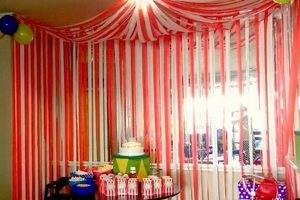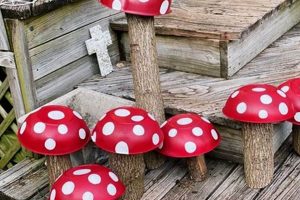Festive centerpieces, handcrafted ornaments, and personalized place settings are elements utilized to create a celebratory atmosphere on a dining surface during the Yuletide season. These decorative items, often constructed from readily available or repurposed materials, add a personal touch to holiday gatherings. Examples include miniature Christmas trees fashioned from felt, pinecone arrangements adorned with glitter, and hand-painted name cards indicating seating arrangements.
The incorporation of homemade embellishments offers several advantages. It provides an opportunity for creative expression and personalized design, departing from mass-produced alternatives. Furthermore, it can be a cost-effective approach to holiday decorating, particularly when utilizing recycled materials. Historically, crafting ornaments and decorations was a prevalent tradition, fostering a sense of community and shared creativity during the holiday season. This practice contributes to a warmer, more intimate ambiance than commercially available decor often achieves.
Subsequent sections will explore specific techniques for crafting these festive elements, material selection considerations, and design principles that contribute to an aesthetically pleasing and cohesive holiday tablescape. The aim is to equip individuals with the knowledge and inspiration to design memorable and uniquely personal holiday dining environments.
Essential Guidelines for Holiday Tabletop Embellishments
The following are recommended practices for achieving an aesthetically pleasing and functional display during the holiday season.
Tip 1: Theme Consistency: Establish a cohesive theme that unifies all elements. A rustic theme, for example, could incorporate natural materials such as wood slices, burlap, and pinecones. Conversely, a modern theme might utilize metallic accents, geometric shapes, and a minimalist color palette. Consistent thematic application ensures a harmonious visual experience.
Tip 2: Scale and Proportion: Carefully consider the dimensions of the table and the relative size of each decorative element. Overly large centerpieces can obstruct conversation and limit space for serving dishes. Smaller, more delicate items may be overwhelmed by the surrounding environment. Strive for proportional balance.
Tip 3: Color Palette Restraint: Limit the color scheme to a maximum of three to four complementary hues. Excessive color variation can create visual clutter and detract from the overall aesthetic. A balanced color palette enhances visual appeal.
Tip 4: Height Variation: Incorporate varying heights to add visual interest. Tall candles, elevated centerpieces, and layered place settings can create a dynamic and engaging display. Avoid a flat, monotonous arrangement.
Tip 5: Practicality and Functionality: Ensure that decorative elements do not impede the serving or consumption of food. Avoid placing items directly in the path of diners or obstructing access to essential serving dishes. Prioritize practicality alongside aesthetics.
Tip 6: Natural Elements Integration: Incorporate natural elements such as fresh greenery, berries, or flowers to add texture and organic appeal. These elements can be sourced locally or foraged responsibly. Natural materials enhance the visual and tactile experience.
Tip 7: Lighting Considerations: Utilize ambient lighting to enhance the mood and highlight key decorative elements. Candles, string lights, or strategically placed spotlights can create a warm and inviting atmosphere. Proper lighting elevates the overall presentation.
Adhering to these guidelines facilitates the creation of visually appealing and functional holiday tabletop arrangements, enhancing the dining experience for all participants.
The following sections will provide detailed instructions for specific crafting projects, further enabling the creation of personalized holiday decor.
1. Material Selection
Material selection is a foundational element in the creation of “christmas diy table decor”. The chosen materials dictate the aesthetic, durability, and overall impact of the holiday table setting. Careful consideration of material properties and thematic appropriateness is essential for achieving a desired outcome.
- Natural Elements
Natural elements such as pinecones, branches, berries, and wood slices contribute to a rustic and organic aesthetic. Their role extends beyond mere decoration; they evoke the sensory experience of the outdoors within the indoor setting. For example, a centerpiece constructed from bundled cinnamon sticks and dried orange slices imparts a warm, spicy aroma. However, using untreated natural materials can introduce insects or decay over time, requiring proper preservation techniques.
- Textiles and Fabrics
Textiles such as burlap, felt, and linen provide textural contrast and can be employed in table runners, placemats, and napkin rings. The choice of fabric impacts the perceived formality of the setting; linen suggests elegance, while burlap conveys a more casual ambiance. A practical implication is the selection of stain-resistant fabrics to mitigate potential spills during holiday meals. Furthermore, the texture of fabrics affects the tactile experience for guests.
- Metallic Accents
Metallic materials, including gold, silver, and copper, introduce a touch of opulence and sophistication. They can be incorporated through metallic paint, glitter, or decorative ornaments. For instance, hand-painted pinecones with gold accents provide a subtle shimmer. However, excessive use of metallic elements can create a gaudy or overwhelming effect. A balanced approach, incorporating metallic accents sparingly, is recommended.
- Recycled and Repurposed Materials
The utilization of recycled materials aligns with sustainable practices and offers unique design opportunities. Examples include using mason jars as candle holders or repurposing old book pages into paper ornaments. Employing these materials not only reduces waste but also adds a sense of history and character to the table decor. The practical consideration involves ensuring the safety and cleanliness of recycled materials before integration into the table setting.
In conclusion, material selection is a critical factor determining the aesthetic and functional qualities of “christmas diy table decor”. The careful consideration of material properties, thematic appropriateness, and sustainable practices contributes to a memorable and impactful holiday dining experience.
2. Color Harmony
Color harmony, in the context of “christmas diy table decor,” is a critical factor influencing the visual appeal and emotional impact of the setting. The selection and arrangement of colors can either enhance or detract from the desired festive atmosphere. Color harmony entails the creation of a balanced and visually pleasing composition through the strategic use of color relationships. A lack of color harmony can result in a chaotic or jarring effect, undermining the overall design. For instance, a table setting incorporating clashing shades of red, green, and purple, without a unifying neutral tone, may appear visually overwhelming and less inviting. Conversely, a carefully curated palette of muted greens, golds, and creams can evoke a sense of understated elegance and warmth. The cause-and-effect relationship is clear: deliberate color choices lead to a cohesive and aesthetically pleasing outcome, while haphazard selection can result in visual discord.
The importance of color harmony extends beyond mere aesthetics; it directly affects the mood and perception of the dining experience. Certain color combinations, such as warm reds and oranges, can stimulate appetite and create a convivial atmosphere. Cooler tones, like blues and silvers, may evoke a more formal and serene ambiance. Practical applications involve understanding basic color theory, including complementary, analogous, and triadic color schemes. For example, a complementary color scheme using red and green can be tempered with white or gold to create a balanced and festive look. A real-life example includes a table setting featuring a deep green tablecloth, accented with red berries and gold-toned candles. This balanced combination creates a classic Christmas aesthetic without being visually overwhelming. Furthermore, the incorporation of neutral tones, such as cream or beige, can provide visual relief and prevent the color scheme from becoming too intense.
In summary, color harmony is a fundamental component of successful “christmas diy table decor.” It involves the deliberate selection and arrangement of colors to create a visually pleasing and emotionally resonant environment. Challenges may arise in balancing traditional Christmas colors with individual preferences and design goals. However, a strong understanding of color theory and a commitment to thoughtful planning can overcome these obstacles. Ultimately, the effective application of color harmony transforms a simple table setting into a memorable and inviting holiday centerpiece.
3. Centerpiece Design
Centerpiece design occupies a central role within “christmas diy table decor,” functioning as the focal point around which the overall aesthetic is structured. Its visual prominence dictates the tone and style of the entire table setting, thereby necessitating careful planning and execution.
- Scale and Proportion
The dimensions of the centerpiece must be proportional to the table size and the number of diners. An oversized centerpiece can obstruct sightlines and hinder conversation, while an undersized one may appear insignificant. Example: A long, narrow table may benefit from a linear arrangement of candles and greenery, while a round table can accommodate a more voluminous, symmetrical design. Improper scale disrupts the visual balance of the table.
- Thematic Consistency
The centerpiece should align with the overarching theme of the Christmas decor. A rustic theme may incorporate natural elements like pinecones and burlap, whereas a modern theme could feature metallic accents and minimalist designs. Inconsistent themes create a disjointed and unharmonious appearance. For instance, placing a brightly colored, contemporary sculpture on a table otherwise adorned with traditional Christmas elements creates a thematic conflict.
- Material Composition
The selection of materials impacts the texture, color palette, and overall visual weight of the centerpiece. Natural materials provide warmth and organic appeal, while metallic elements introduce sophistication and shimmer. Example: Combining fresh evergreen boughs with silver ornaments results in a visually appealing contrast. Improper material selection can lead to a dull or overwhelming centerpiece.
- Height and Dimension
Varying the height and dimension of elements within the centerpiece creates visual interest and prevents a flat, monotonous appearance. Tall candles, elevated platforms, and layered arrangements can add depth and dynamism. A centerpiece consisting solely of items at the same height lacks visual appeal. Introducing layers and levels elevates the centerpiece from a simple decoration to a complex work.
The interplay between these facets of centerpiece design significantly contributes to the success of “christmas diy table decor.” Skillful manipulation of scale, theme, materials, and dimension enables the creation of a visually striking and thematically appropriate focal point, enhancing the overall dining experience.
4. Place Settings
Place settings, as a component of “christmas diy table decor,” directly influence the overall aesthetic and perceived quality of the dining experience. Their arrangement and design contribute significantly to the festive ambiance and indicate a level of attention to detail. The cause-and-effect relationship is evident: thoughtfully designed place settings enhance the sense of occasion, whereas neglected or mismatched settings can detract from the dining experience. As individual spaces for each diner, they act as miniature stages showcasing personalized elements within the broader decorative theme. Real-life examples might include handcrafted name cards, personalized ornament favors, or creatively folded napkins, each adding a unique touch. The practical significance of understanding this connection lies in the ability to elevate a simple meal into a memorable celebration through careful curation of individual spaces. Properly executed place settings enhance comfort, ease of access to dining implements, and add to the joyful atmosphere.
Further analysis reveals that effective place settings are not merely decorative; they are functional. The proper arrangement of cutlery, glassware, and dinnerware ensures ease of use for each guest. A practical application involves considering the menu when designing place settings, providing appropriate utensils for each course. For example, if soup is included, a soup spoon must be present; if fish is served, a fish fork and knife are required. Napkin placement, whether to the left of the forks or on the plate, can contribute to visual symmetry and practicality. Moreover, personalized elements, such as handwritten notes or small gifts, can create a sense of individual attention and appreciation. The intentionality behind each item, from the charger plate to the water glass, conveys a message of hospitality and care.
In summary, place settings are integral to “christmas diy table decor,” affecting both the visual appeal and functional aspects of the dining environment. Challenges may arise in balancing personalization with thematic consistency, or in maintaining functionality without sacrificing aesthetics. However, by understanding the connection between design and utility, and by paying attention to detail, one can create place settings that enhance the overall holiday experience. The effective integration of place settings elevates the simple act of dining into a celebration of artistry and hospitality.
5. Lighting Effects
Lighting effects are a crucial element within the domain of “christmas diy table decor,” fundamentally shaping the ambiance and visual impact of the setting. Deliberate manipulation of light enhances the festive atmosphere, accentuates decorative features, and influences the overall sensory experience. Strategic deployment of light transforms a mundane table into a captivating focal point during holiday gatherings.
- Candlelight Illumination
Candlelight introduces warmth and intimacy, fostering a sense of tranquility and tradition. The flickering flame provides a soft, diffused light that accentuates textures and casts gentle shadows. Practical applications involve the use of varying candle heights to create visual interest and the selection of scented candles to enhance the olfactory experience. However, safety precautions are paramount; candles must be placed away from flammable materials and supervised at all times. Real-life examples include arrangements of pillar candles nestled within greenery or floating candles in water-filled bowls, adding a touch of magic.
- String Lighting Integration
String lights offer versatility and flexibility in design, allowing for the creation of intricate patterns and highlighting specific decorative elements. Battery-operated string lights provide convenience and eliminate the need for unsightly cords. For instance, string lights woven through a centerpiece or draped along the edge of a table runner can add a whimsical and festive touch. The color temperature of the lights should be considered; warm white lights create a cozy ambiance, while cool white lights offer a more contemporary aesthetic.
- Spotlighting Techniques
Strategic use of spotlights can draw attention to key decorative elements, such as a handcrafted centerpiece or a collection of ornaments. Small, battery-operated spotlights can be discreetly placed to illuminate these features, creating focal points and adding depth to the table setting. Real-life examples include spotlights directed at ice sculptures or intricate floral arrangements, enhancing their visual impact. Improperly positioned spotlights, however, can create harsh shadows and detract from the overall aesthetic.
- Color Temperature Modulation
The color temperature of lighting sources significantly affects the perceived warmth and ambiance of the table setting. Warm lighting (2700-3000K) creates a cozy and inviting atmosphere, while cool lighting (4000-5000K) offers a more modern and crisp appearance. Combining different color temperatures can create visual contrast and highlight specific elements. For instance, using warm white string lights in conjunction with cool white spotlights can add depth and dimension to the table decor.
In conclusion, lighting effects play a pivotal role in shaping the aesthetic and emotional impact of “christmas diy table decor.” Skillful manipulation of candlelight, string lights, spotlights, and color temperature enhances the festive atmosphere and accentuates decorative features. By carefully considering these facets, individuals can create a captivating and memorable holiday dining experience.
6. Thematic Consistency
Thematic consistency is a foundational principle in the execution of visually cohesive “christmas diy table decor.” It ensures that all elements, from the centerpiece to the place settings, contribute to a unified aesthetic, enhancing the overall ambiance and impact of the holiday table. Deviations from a consistent theme can result in a disjointed or confusing visual experience, diminishing the intended festive effect.
- Color Palette Alignment
A cohesive color palette is essential for thematic consistency. All decorative elements should adhere to a pre-determined color scheme, typically involving two to three primary colors and one to two accent colors. For example, a rustic theme might utilize earth tones such as browns, greens, and creams, while a modern theme could incorporate metallics like silver and gold alongside a primary color like deep blue. Inconsistent color choices disrupt the visual harmony and detract from the overall theme.
- Material Selection Integration
The materials used in the table decor must be consistent with the chosen theme. A natural theme might incorporate wood, burlap, and pinecones, whereas a glamorous theme could feature crystal, silk, and metallic accents. The integration of disparate materials can create visual dissonance, undermining the intended aesthetic. For instance, placing plastic ornaments on a table designed with natural, rustic elements would violate the principle of material consistency.
- Style and Motif Unification
The style and motifs employed throughout the table decor should align with the chosen theme. A traditional Christmas theme might feature classic motifs such as snowflakes, reindeer, and Santa Claus, while a contemporary theme could utilize geometric shapes and minimalist designs. Inconsistencies in style can create a jarring effect, diluting the thematic impact. For example, incorporating cartoonish characters into a sophisticated, elegant table setting would disrupt the intended ambiance.
- Ornamentation Coordination
The selection and placement of ornaments must support the overall theme. A minimalist theme might feature a few carefully chosen, understated ornaments, while a maximalist theme could incorporate a profusion of elaborate decorations. The ornamentation should complement the other elements of the table decor, contributing to a cohesive and visually appealing display. Overcrowding the table with irrelevant or mismatched ornaments can detract from the intended thematic expression.
Achieving thematic consistency in “christmas diy table decor” requires careful planning and attention to detail. By aligning color palettes, material selections, style motifs, and ornamentation, a unified and visually impactful holiday table can be created, enhancing the dining experience and contributing to a festive atmosphere.
Frequently Asked Questions
This section addresses common inquiries and misconceptions regarding the creation and implementation of festive, handcrafted dining table arrangements.
Question 1: What is the optimal timeframe for commencing “christmas diy table decor” projects?
Initiating preparation several weeks prior to the holiday provides ample time for material acquisition, crafting, and design refinement. This allows for unforeseen delays and prevents rushed execution.
Question 2: How can budgetary constraints impact the feasibility of creating elaborate “christmas diy table decor”?
Resourcefulness is key. Utilizing recycled materials, foraging natural elements, and strategically sourcing affordable crafting supplies can minimize expenses without sacrificing aesthetic appeal.
Question 3: What are the essential safety considerations when incorporating candles into “christmas diy table decor”?
Candles should be placed away from flammable materials, secured in stable holders, and never left unattended. Battery-operated alternatives offer a safer, albeit less traditional, option.
Question 4: How does one ensure that the “christmas diy table decor” complements existing home decor?
Adhering to a consistent color palette, thematic style, and level of formality can seamlessly integrate the table decor with the surrounding environment. A pre-determined design plan is crucial.
Question 5: What strategies can be employed to protect delicate “christmas diy table decor” from potential damage during a holiday meal?
Utilizing protective placemats, coasters, and tablecloths can mitigate spills and prevent scratches. Delicate items should be placed strategically to minimize the risk of accidental contact.
Question 6: How can one effectively store “christmas diy table decor” for future use?
Fragile items should be individually wrapped in acid-free tissue paper and stored in sturdy containers in a cool, dry location. Proper storage prolongs the lifespan and aesthetic integrity of handcrafted decorations.
In essence, careful planning, resourcefulness, and attention to detail are fundamental to the successful creation and preservation of memorable holiday dining table arrangements.
The following sections will explore additional resources and inspirations for crafting unique holiday table designs.
Conclusion
The preceding exploration of “christmas diy table decor” has encompassed various facets, from material selection and color harmony to centerpiece design, place settings, lighting effects, and thematic consistency. The synthesis of these elements, when executed with diligence and attention to detail, yields a dining environment that transcends mere functionality, transforming into a celebratory expression of artistry and hospitality. The application of these principles is instrumental in crafting memorable and engaging holiday experiences.
As individuals embark on the creation of their own festive tabletops, a commitment to informed decision-making and creative experimentation is paramount. The potential for personalized expression within this domain is vast, inviting continual refinement and adaptation. The enduring value of handmade embellishments lies not only in their aesthetic appeal but also in their capacity to cultivate a sense of warmth and shared experience during the holiday season. Therefore, the pursuit of distinctive holiday decor is a worthwhile endeavor, enriching the traditions and memories associated with this time of year.







